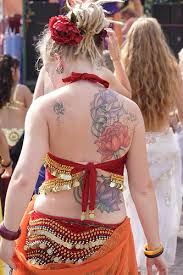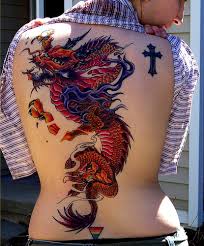Tattoo henna has been used throughout the centuries and around the world to create interesting tattoo designs. Henna is created from a plant called Lawsonia Inermis. When mixed appropriately, it stains any surface it comes in contact with, including skin, fingernails and hair. It has been used for many staining and dying purposes other than tats as well. Today, henna is popularly use for temporary tattoos because while it is an effective staining agent at first;however, it does fade over time. Tattoo Henna
Many people like henna tattoos since they are relatively inexpensive and painless. Henna tattoos, also called Mehndi in some parts of the world, are most often seen on the palm or the back of the hands. Today, people who do not use henna for religious or cultural reasons will put these
Temporary Tattoos anywhere on the body.
The henna is applied by grinding a powder into a paste and applying it with a hollowed tip of a syringe or by using a tiny brush. To apply these temporary tats, some people use a stencil for intricate designs. Other people apply tattoo henna freehand, using only their imagination for ideas. Most of the traditional henna patterns are based on combinations of circles, triangles and lines. Today, flower and vine patterns are popular with those who seek henna tattoos.
Henna ink starts out copper or reddish brown. Over time, it turns dark brown and then fades.
How to Care for Your Tattoo
Tattoo henna will stay on the skin for about one to four weeks. Obviously, the more you wash the area with the tattoo, the faster it will fade. If you must get your tattoo wet within the first 48 hours after application, it is recommended that you apply Vaseline or baby oil to protect it.
You can reapply the henna to your tattoo, but it will only work for four to five applications. After that, there is nothing you can do to keep your tattoo from fading.
Henna Meets Fingernails and Hair
Historically men and women have used Henna to color the fingernails. Henna is actually an anti-fungal and can strengthen fingernails, so it makes sense people would want to use it.
Henna is also used to color and condition hair. It can add a bit of reddish color to your hair, depending on your original hair color. It is completely natural and better for your hair and skin than chemical hair coloring products. However, it fades faster than commercial hair colorants.
Mehndi
Mehndi is the Hindi word used to describe henna and henna body painting. Mehndi is used in many parts of the world, but is seen primarily in India, Pakistan, other parts of the Middle East and North Africa. Mehndi is commonly worn by the bride during a wedding ceremony in these cultures. Mehndi are the extremely intricate designs seen on the palms and backs of the hands. Some artists even glue rhinestones onto the art. Mehndi is also used on religious occasions and as blessings for the birth of a baby and to bring good fortune.
Black Henna and Tattoos
Some people use a product called black tattoo henna for tattoos. It gives temporary tattoos a black look. However, black henna usually contains para-phenylendiamine, which should never go onto the skin. Putting para-phenylendiamine on the skin can cause blistering and scarring. There are other ways to darken henna, like using natural products such as tea tree oil--although some professionals say you should never change the color of henna.
If you are having a professional apply the henna tattoo, ask what ingredients they are using. If you are using a kit to apply it yourself, check the ingredients listing.








 sexy angel wings tattoos gallery images are very good with a variety of new collections with a variety of types
sexy angel wings tattoos gallery images are very good with a variety of new collections with a variety of types














